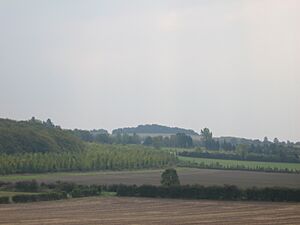Where Troy Once Stood facts for kids
| Author | Iman Jacob Wilkens |
|---|---|
| Country | United Kingdom |
| Language | English |
| Subject | Trojan War |
| Genre | Non-fiction |
|
Publication date
|
1990 |
| Pages | 365 pages |

Where Troy Once Stood is a book from 1990 by Iman Jacob Wilkens. In this book, Wilkens suggests a very different idea about the famous city of Troy. He argues that Troy was actually located in England, not in Turkey where most people believe it was. He also thinks the Trojan War was fought between different groups of Celts.
Most experts believe Troy was near the Dardanelles in Turkey. But Wilkens claims that Homer's epic poems, the Iliad and the Odyssey, actually came from Western Europe. He thinks these stories were passed down by word of mouth for a long time before they were written down in ancient Greece.
Wilkens' ideas are quite different from what most scholars believe. Because of this, his work hasn't had much influence among professional historians and archaeologists. The title of his book comes from a quote by the Roman poet Ovid: "Now there are fields where Troy once stood..."
Contents
Wilkens' Big Ideas About Troy's Location
Iman Jacob Wilkens suggests that the ancient city of Troy was located in England. He points to the Gog Magog Hills in Cambridgeshire as the possible site.
He believes that Celtic people living in this area were attacked around 1200 BC. The attackers were also Celts, but from mainland Europe. Wilkens thinks they fought over access to the important tin mines in Cornwall. Tin was a very valuable metal needed to make bronze.
Wilkens also has a theory about the Sea Peoples. These were groups of people who moved around the Mediterranean Sea in the Late Bronze Age. He thinks they were Celts who settled in Greece and the Aegean Islands. He calls them the Achaeans and Pelasgians.
He believes these Celts brought the stories that became the Iliad and the Odyssey with them from Western Europe. Wilkens suggests that these poems were told orally for about 400 years. Then, around 750 BC, they were translated and written down in Greek.
He thinks the Greeks who wrote them down had forgotten where the stories originally came from. So, they placed the events in the Mediterranean, where they found similar-sounding place names. However, Wilkens argues that the descriptions of towns, islands, and sailing directions in the poems don't quite fit the Mediterranean geography.
He also claims that Homer's Greek language has many words borrowed from Western European languages, especially Dutch. However, language experts say that Dutch and other modern European languages didn't exist until much later, about 1000 years after Homer.
Wilkens also suggests that the Odyssey took place in the Atlantic Ocean, not the Mediterranean Sea. For example, he believes the dangerous passage of Scylla and Charybdis was actually at St Michael's Mount in England.
What Evidence Does Wilkens Use?
To support his ideas, Wilkens looks at different types of evidence.
- Archaeology: He uses findings like the Isleham Hoard, a collection of Bronze Age items found in England. He believes this hoard was found near the battlefield of the Trojan War.
- Place Names: He uses etymological evidence, which is the study of where words and names come from. For instance, he suggests that Homer's Ismaros was actually Ys in Brittany, France. He also thinks Homer's Sidon was Medina Sidonia in Spain.
- Land Features: Wilkens argues that Homer described places around the Atlantic Ocean with very specific topographical features. These are the natural shapes and features of the land.
He also believes that some English river names are similar to river names near Troy in the Iliad. In a later edition of his book, he even included a map showing how the Trojan battlefield might have looked in Cambridgeshire.
Wilkens suggests that Cadiz in Spain matches Homer's description of Ithaca: There is in the land of Ithaca a certain harbour of Phorcys, the old man of the sea, and at its mouth two projecting headlands sheer to seaward, but sloping down on the side toward the harbour...
He also thinks that Havana in Cuba looks a lot like Homer's description of Telepylos: The harbour, about which on both sides a sheer cliff runs continuously, and projecting headlands opposite to one another stretch out at the mouth, and the entrance is narrow, ..., and the ships were moored within the hollow harbour, for therein no wave ever swelled, great or small, but all about was a bright calm...
Who Else Had Similar Ideas?
Wilkens mentions a few other people who had similar thoughts before him:
- Théophile Cailleux: A Belgian lawyer who wrote in 1879 that Odysseus sailed the Atlantic Ocean. He also placed Troy near the Wash in England.
- Karel Jozef de Graeve: A Flemish council member who believed that the history and myths in Homer's work came from Western Europe, around the Rhine–Meuse–Scheldt delta. His ideas were published after he died in 1806.
About the Author
Iman Jacob Wilkens was born on March 13, 1936, in Apeldoorn, Netherlands. He studied Economics at the University of Amsterdam. From 1966, he lived in France and spent over thirty years researching Homer. He passed away on May 4, 2018.
Images for kids
-
According to Wilkens, St Michael's Mount is the site of Scylla and Charybdis
-
Cadiz: Ithaca?




